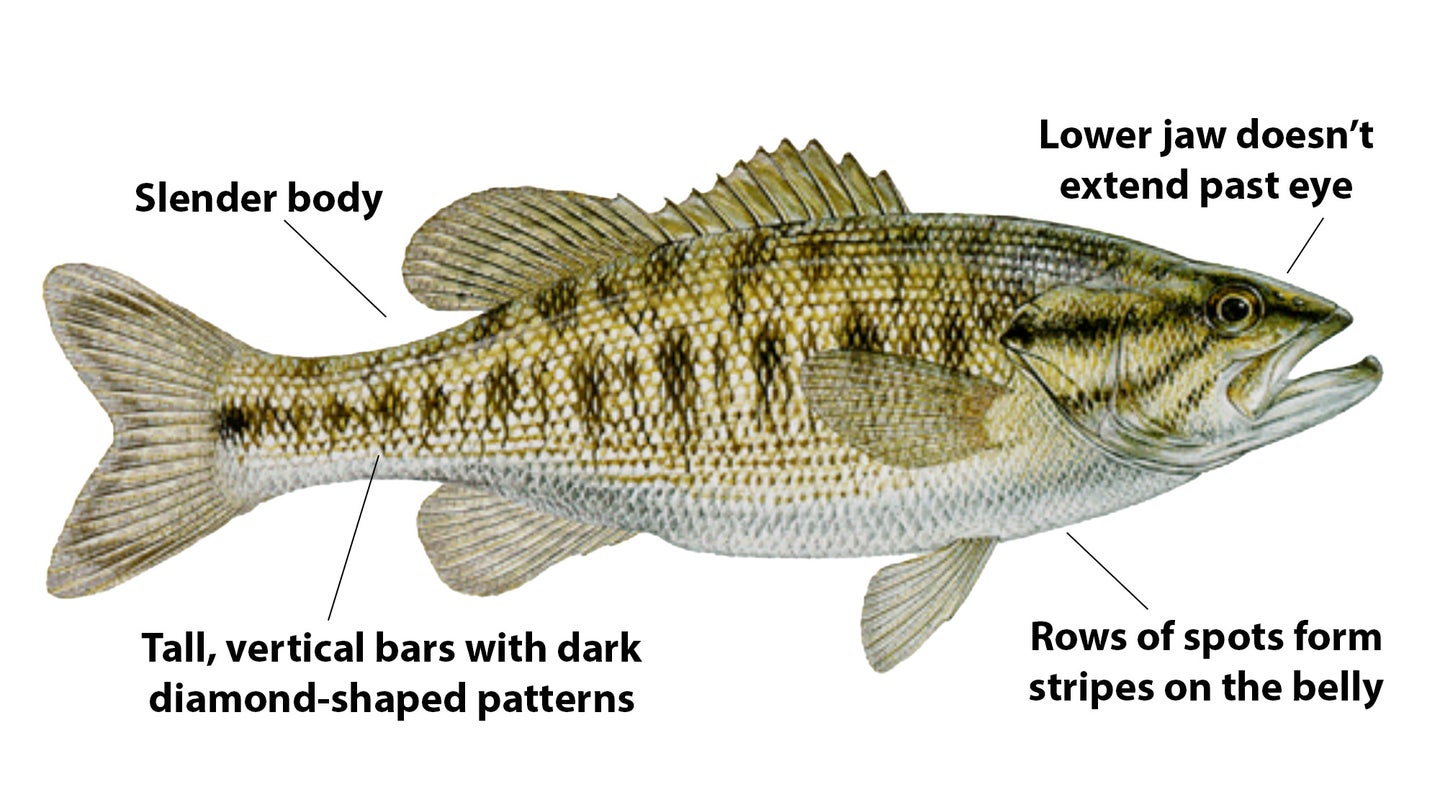Guadalupe Bass: Species Profile

Texas Parks and Wildlife Department / Field & Stream
You know it’s something special when they keep a backup supply. That’s the deal with a cool little Texas species known as the Guadalupe bass.
Named after the Guadalupe River that runs through the Texas Hill Country of its origin, this member of the black bass clan likes the swift flowing streams of the Edwards Plateau region. First identified as a largemouth bass subspecies in the 1870s, the Guadalupe was later reclassified as part of the spotted bass sector.
By the 1950s, Dr. Clark Hubbs of the University of Texas sorted it all out and Micropterus treculii had its own identity. In 1989, the Guadalupe bass became the state fish.
Their native range extends from the Brazos River up north to the San Antonio River basin down south.
Reserve Supplies
According to Preston Bean of the Texas Parks and Wildlife Department’s Division of Inland Fisheries, there are no known populations outside of Texas, but the state has stocked Guadalupe bass in the Sabinal and Nueces rivers. Both are part of the Nueces River basin, the next adjacent basin to the south of the Guadalupe’s native range.
Bean said TPWD introduced Guadalupe bass into the Nueces in the 1960s for recreational opportunities and in the Sabinal River in 1988 as a refuge population for conservation purposes.
“The biggest threat to Guadalupe is hybridization with smallmouth bass, so to have a backup population, we stocked (pure Guadalupe) fingerling in the Sabinal River,” he said. “If we need them later on for brood stock, we have another source.”
Guadalupe Bass: Physical Features
Feisty for their size, adult Guadalupe bass average about 12-13 inches, while those above 15 inches garner trophy status.
“The maximum length we have documented is 18.9 inches in the Lower Colorado River,” Bean said. “The record Guadalupe bass was 3.71 pounds and 17.25 inches. That was a prespawn female, also in the Lower Colorado.”
As Bean explained, the Guadalupe’s coloration is its most immediate identifier. Tall vertical bars with dark diamond-shaped patterns flank the sides, while rows of spots form stripes on the belly.
They have smaller mouths, too, as their lower jaw doesn’t extend past the eye like a largemouth. They’re also more slender and streamlined than a largemouth. Similar to spotted bass, they also have a small tooth patch on their tongue. As such, if you’re fishing in an area with smallmouth bass and you catch a fish that looks like it might be a Guadalupe bass without a tooth patch, it’s most likely a hybrid.
Habitat Preference
Unlike their largemouth cousins, Guadalupe bass are well adapted for life in and near moving water. In a stream scenario, you’ll typically find the homebody largemouth in slower pools where food is more easily captured with a hide-and-ambush approach.
Guadalupe bass won’t necessarily avoid the tranquil pools, but they do their best work in the runs and riffles. Younger fish — 1-2 years old — tend to frequent swifter water, especially where vegetation avails.
For quality fish, Bean suggests targeting targeting boulder piles, laydowns near current, root masses, undercut banks, and cypress trees. Such features typically present food-rich habitat that interests larger Guadalupe bass.
As Bean notes, spawning Guadalupe bass don’t make as much of a defined nest as largemouth. Rather, they’ll find an attractive substrate in an eddy or behind a stump and simply dust it off.
Top Fishing Tactics for Guadalupe Bass
Want to catch one of these sporty little fish? Bean suggests a two-tiered approach.
“Many people just want to check off a unique species, so inline spinners are good for covering water to find fish,” he said. “If you fish this bait around the right habitat, you’ll get plenty in the 8- to 10-inch range.”
For better quality Guadalupe bass, Texas-rigged craws, 3- to 4-inch Senkos, or small creature baits with enough weight to quickly reach and hold bottom do the tick. The spinners, along with small swimbaits will also tempt the occasional photo-worthy Guadalupe, but Texas rigs allow you to pinpoint high-value targets and keep a bait in the strike zone.
Put ‘Em Back
There’s no size limit on Guadalupe bass and this species is included in the five-fish aggregate daily limit for black bass.
There’s no size limit on Guadalupe bass, and this species is included in the five-fish aggregate daily limit for black bass. With no lack of crappie and catfish in Texas waters, Guadalupe bass aren’t going to win any fish fry contests; so while it’s legal to keep them, it’s mostly a catch-and-release species.
Hold them with wet hands, avoid touching the eyes or gills, and grip by the lower jaw to prevent rubbing away the slime coat that helps protect the fish from all kinds of harsh stuff. Snap your photo and gently drop your catch near that swift water.
“During the summer, rivers and streams can get pretty warm, so avoid fishing during this stressful time,” Bean said. “If you do fish during the hotter months, fish early and late, and fish in deeper, cooler areas.
“Guadalupe are pretty hardy fish, but during the summer, low oxygen levels makes it harder on them.”
Even with a backup population, preserving the Guadalupe Bass is worth a little extra effort.
The post Guadalupe Bass: Species Profile appeared first on Field & Stream.
Articles may contain affiliate links which enable us to share in the revenue of any purchases made.
